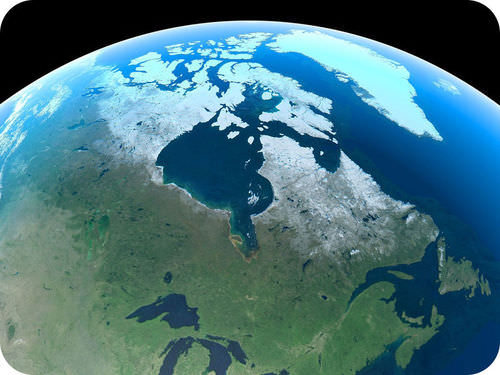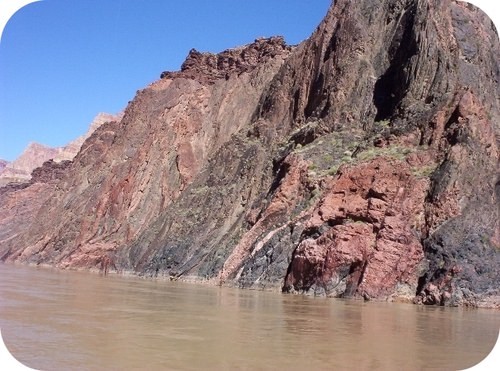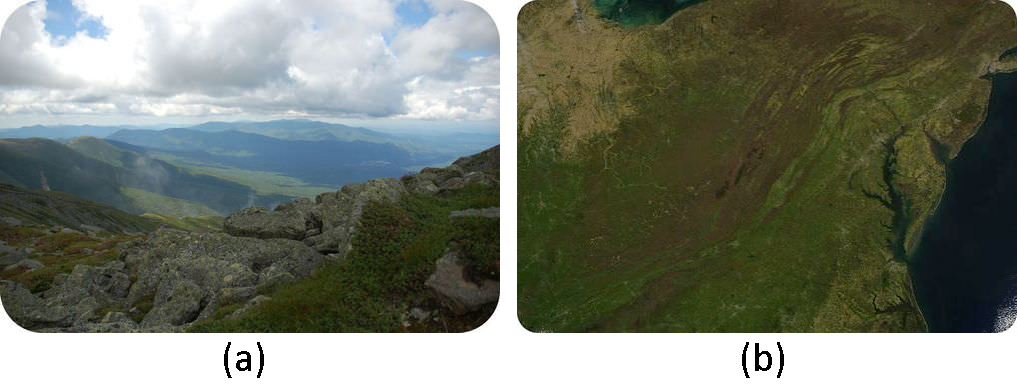31 Supercontinents
Early Continents
The first crust was made of basaltic rock, like the current ocean crust. Partial melting of the lower portion of the basaltic crust began more than 4 billion years ago. This created the silica-rich crust that became the felsic (i.e. crust with high content of silica) continents.
Craton
The earliest felsic continental crust is now found in the ancient Pre=Archean and Archean) cores of continents, called the cratons.
Geologists can learn many things about the Pre-Archean by studying the rocks of the cratons.
- Cratons also contain felsic igneous rocks, which are remnants of the first continents.
- Cratonic rocks contain rounded sedimentary grains. Of what importance is this fact? Rounded grains indicate that the minerals eroded from an earlier rock type and that rivers or seas also existed because roundness in mineral grains can be achieved only by the movement of water.
Shield
Places the craton crops out at the surface is known as a shield. Many Precambrian shields are about 570 million years old (Figure 2). Examples: Canadian shield, Ukrainian shield, etc.

Platform
In most places the cratons were covered by younger rocks, which together are called a platform. Sometimes the younger rocks eroded away to expose the Precambrian craton (Figure3).

Early Convection
During the Pre-Archean and Archean, Earth’s interior was warmer than today. Mantle convection was faster and plate tectonics processes were more vigorous. Since subduction zones were more common, the early crustal plates were relatively small.
Since the time that it was completely molten, Earth has been cooling. Still, about half the internal heat that was generated when Earth formed remains in the planet and is the source of the heat in the core and mantle today.
The presence of water on ancient Earth is revealed in a zircon crystal:
Supercontinent Cycle
Look at Figure 4; is this Earth?

The existence of Wegener’s supercontinent Pangaea is completely accepted by geologists today. The movements of continents explain so much about the geological activity we see. But did it all begin with Pangaea? Or were there other supercontinents that came before? What does the future of the continents hold?
Pangaea
Wegener had lots of evidence for his continental drift hypothesis. One line of evidence was the similarity of the mountains on the west and east sides of the Atlantic. Those mountains rose at convergent plate boundaries. The continents on both sides of the ocean (where the Atlantic is now) smashed together to create Pangaea about 270 million years ago. The proto-Atlantic ocean shrank as the Pacific Ocean grew.
 Figure 5. Pangea broke up to become our modern continents.
Figure 5. Pangea broke up to become our modern continents.
The Appalachian mountains of eastern North America formed at this convergent plate boundary (Figure 6a). About 200 million years ago, they were probably as high as the Himalayas.
 Figure 6. (a) The Appalachian Mountains in New Hampshire. (b) The Appalachians along the eastern U.S. These mountains began when North America and Eurasia collided as Pangaea came together.
Figure 6. (a) The Appalachian Mountains in New Hampshire. (b) The Appalachians along the eastern U.S. These mountains began when North America and Eurasia collided as Pangaea came together.The Supercontinent Cycle
Back before Pangaea, there were earlier supercontinents. Rodinia existed 750 million to 1.1 billion years ago. Columbia existed 1.5 to 1.8 billion years ago. If the continents continue in their current directions, they will come together to create a supercontinent on the other side of the planet in around 200 million years.
This is known as the supercontinent cycle. The continents smash together on opposite side of the planet around every 500 million years. The creation of supercontinents is responsible for most of the geologic features that we see. It is responsible for many features that are long gone.
This animation shows the movement of continents over the past 600 million years, beginning with the breakup of Rodinia.
Supercontinent Cycle includes Ocean Basins Cycle, also known as a Wilson Cycle
Song below was written by GEO101 student Jose Castaner at Lehman College, 2017 and combined with a video to illustrate a Wilson cycle, a theory that describes the lifecycle of the ocean basin:
As you can see, it is very common for oceans to form and then disappear. Continental rifting plays a key role in the formation of an ocean.
Summary
- The ancient core of a continent, at and beneath the surface, is its craton.
- The cratonic rock that is seen at the surface is called the shield. Where the shield is covered by younger sediments is the platform.
- Convection on early Earth was faster and so plate tectonics was faster. Since then, Earth has been cooling.
- Pangaea came together as a set of continent-continent convergent plate boundaries.
- Pangaea is still breaking up as the continents move apart. The Atlantic Ocean is getting bigger, and the Pacific Ocean is getting smaller.
- The continents come together and break apart about every 500 million years. This is called the supercontinent cycle.
